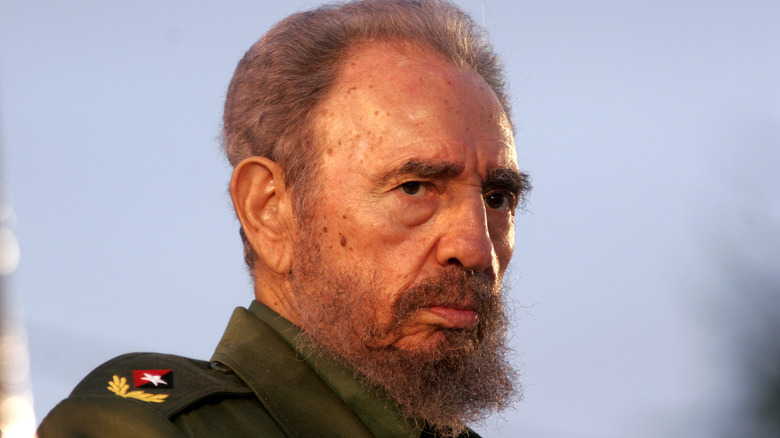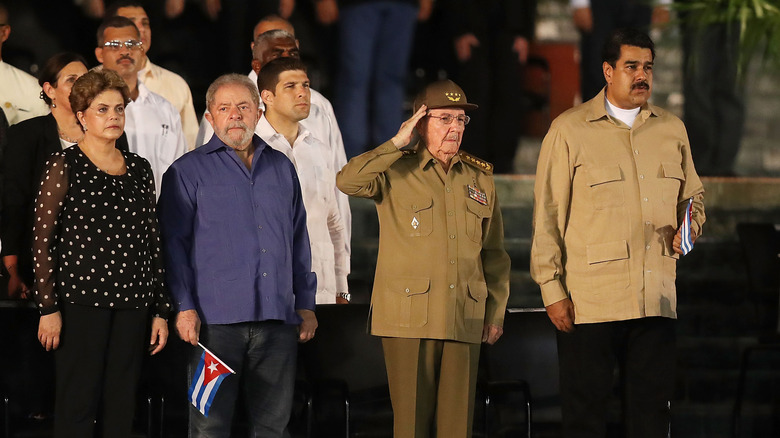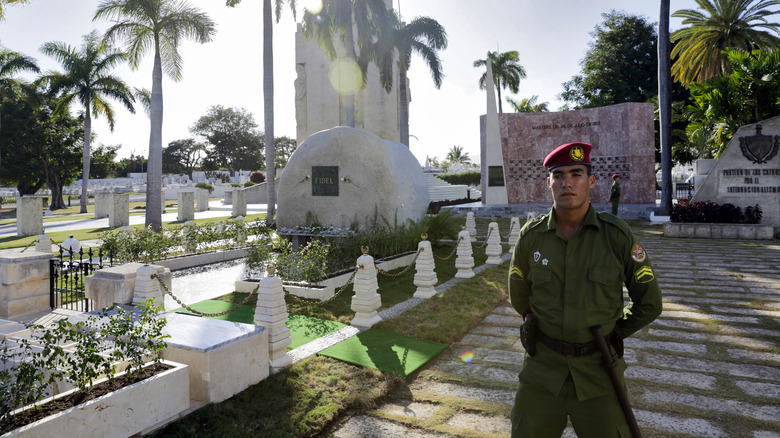What Happened To Fidel Castro's Body?
The Communist leader of Cuba, Fidel Castro, made many enemies during his long life as a revolutionary, especially in the U.S., the nation that had upheld an embargo against Castro's country for more than 60 years. Famously, the CIA and various groups of Cuban exiles plotted to assassinate the Cuban leader more than 600 times over half a century, with schemes that included the use of exploding cigars and a poisoned diving suit. Nevertheless, Castro survived, and on November 25, 2016, he died at the grand old age of 90 of natural causes, having ceded control of Cuba to his brother Raúl eight years earlier.
The death of Fidel Castro, known affectionately as El Comandante by his allies, was one of the biggest events in Cuban history, and while the expatriated Cuban communities living in Florida celebrated his demise, many of those in Havana were deeply shocked by the death of a seismic figure who had shaped their nation in a manner few have anywhere on the planet. As the Cuban playwright Norge Espinosa Mendoza observed: "It's the end of an era. In his time he managed to leave no one indifferent ... His charisma, his speeches, his impulses, and also his errors gave the world another view of Cuba" (via The Guardian). The scale of his state funeral, which involved his cremation and eventually interment in Havana, is a testament to his place in history.
Fidel Castro's cremation
The death of Fidel Castro was announced on Cuban state television by the island nation's president at the time Raúl Castro, and quickly spread around the world through news outlets such as the BBC, who highlighted the outpouring of emotions his death triggered among both his allies and his enemies. Raúl, who was audibly close to tears while speaking to the nation, declared a national period of mourning in the wake of his brother's death, telling Cubans and the wider world that his brother was set to be cremated the following day, after which his ashes would be present at a memorial allowing the public to pay their respects to the Communist leader.
USA Today notes that the decision was at odds with other prominent Communist leaders, such as China's Mao Zedong and the Soviet Union's Vladimir Lenin, whose embalmed bodies were put on public display for long periods. It is believed that Castro's decision likely stemmed from his desire not to be lionized after his death, and was also an expression of his long-held atheism.
Many top-ranking politicians kept away
Unsurprisingly, even in death, Fidel Castro remained deeply divisive, with his funeral and interment of his remains becoming a diplomatic issue for many world leaders. While his allies venerated his impact on 20th-century world affairs and his longstanding maintenance of Cuba's independence, many others described him as a tyrant and murderer, whose revolution and its aftermath were tantamount to the oppression of his own people.
Politicians and commentators from many Western nations including the United States and the United Kingdom were vocal in their belief that their leaders should in no way legitimize Castro's rule by attending his state funeral. Nevertheless, when the time came the funeral was well attended by delegates from many countries. Thirty heads of state arrived on the island to pay their respects, chiefly Castro's allies, such as South African President Jacob Zuma and Zimbabwe's Robert Mugabe. Meanwhile, non-sympathetic nations tended to send lesser representatives, such as Spain, who sent former king Juan Carlos I. The Guardian noted that the death had caused a "dilemma" for many world leaders, such as Canada's Justin Trudeau, who was criticized for calling Castro a "remarkable leader," and Ireland's Michael D. Higgins who failed to address Cuba's poor human rights record. Those who more successfully walked the tightrope, such as the European Union's Jean-Claude Juncker and former U.S. president Barack Obama, stated that ultimately it would be history that would judge Castro.
His remains were interred days later
The funeral rites for Fidel Castro lasted several days, including a mass gathering at Plaza de la Revolucion in Havana on November 29. After his remains had laid in state in the Cuban capital for two days, four days followed in which Castro's ashes were transported as part of a caravan from Havana to Santiago de Cuba, a 900 kilometer (559 mile) journey which the Havana Times noted was planned to echo in reverse the "Caravan of Freedom" of 1959, a march which Castro had led to commemorate Cuban independence.
On December 4, 2016, Fidel Castro's remains were taken by cortege past crowds of mourners to the Santa Ifigenia cemetery. There, in a private ceremony, the revolutionary's ashes were interred in a recess in a large boulder, which was then marked with a metal plaque that reads simply: "Fidel." According to Cuba Debate, it was a short and "solemn" affair as the controversial leader was laid to rest among many other notable Cuban revolutionaries.


